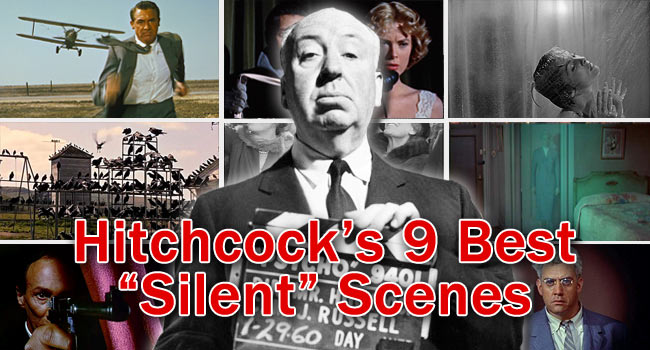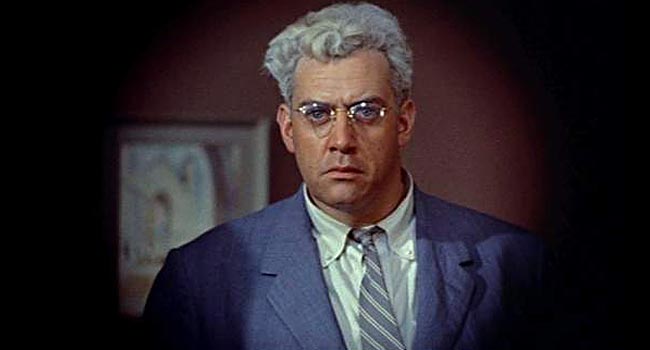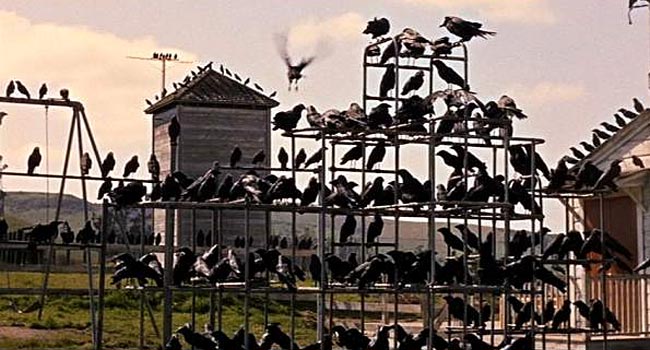Hitchcock’s 9 Best “Silent” Scenes

If you’re in the Bay Area this weekend, I highly recommend you check out the San Francisco Silent Film Festival, which will host the “Hitchcock 9”, a series of films from Hitchcock’s early days as a director in the silent era. These classics have been beautifully restored and will be projected on the big screen with live music. Silent films play a vital role in the history of cinema, and festivals like this are guaranteed to make all your future movie-going experiences richer!
In our first feature honoring the Hitchcock 9, we looked at 9 of the Best “Talkie” scenes from Hitchcock. With this feature we’re going to count down Hitchcock’s 9 Best “Silent” scenes. We chose to include only films made after the Hitchcock 9 to take a look at how he exhibited the tools and principles he learned and retained from the silent era in his later works. Though some of these scenes do have some dialog in them, it’s largely disposable and the scenes work purely because of the imagery and score. Using his vast visual vocabulary and some of cinema’s most unforgettable scores, Hitchcock plays us like Beethoven played his piano.
9 Best “Silent” Scenes from Alfred Hitchcock
#9 — Sabotage (1936) — Bus Bomb

This classic scene got a nice little “cameo” in Quentin Tarantino’s Inglorious Basterds. It’s an almost perfect example of Hitchcock doing what he does better than anybody—creating suspense. I say “almost” because, well…I’ll let the man explain for himself:
A boy is tasked with delivering a package which, unbeknownst to him, contains a bomb that will detonate within minutes. We’re aware of how much danger the boy is in (Hitchcock reminds us with cuts to various clocks), but he isn’t, which is a basic recipe for suspense. Other than the scene’s unsavory conclusion, it’s a classic example of Hitchcock pushing all the right buttons to get us to squirm in our seats.
Watch “Bus Bomb” scene:
#8 — Frenzy (1972) — Fingersnappin’

A serial killer has hidden one of his victims (a young woman) in a potato sack on a truck (Hitchcock was never big on practicality). Minutes later, he notices he’s missing his very distinctive (and incriminating) tie pin, which he realizes she must have snatched during the murder. He returns to the truck to search the mountain of sacks for the one containing the body, when the truck suddenly starts moving. Hilarity ensues! Hitchcock was a master at getting his audience to identify with his villains (see Strangers on a Train, Psycho) and this scene accomplishes this in the funniest fashion. The killer has difficulty wresting the pin from the corpse—he gets a cold dead foot in the face and even gets knocked on his ass a couple times. The body is stricken with rigor mortis, so the killer has to gruesomely break the poor girl’s fingers to pry his pin out of her cold dead hands. It’s like a morbid episode of Mr. Bean.
Watch “Fingersnappin” scene:
#7 — Rear Window (1954) — I See You, You See Me

The nightmare of a voyeur is for the person they’re snooping on to look straight back at them, and Hitchcock captures this vividly and thrillingly in Rear Window. James Stewart has been spying on his neighbors from his apartment window, and we peep along with him (an inventive use of Hitchcock’s patented “subjective” filmmaking). Grace Kelly invades the home of Raymond Burr, and we boil with helpless anxiety as Burr catches her in the act and gets violent. When Burr catches on to the plot and shoots an evil eye at Stewart (and us) it’s a terrifying shock. After countless shots of observing the neighbors from a god’s-eye-view, Burr’s stare feels like a knife in the gut. It’s a great Hitchcock moment.
Watch “I See You, You See Me” scene:
#6 — The Man Who Knew Too Much (1956) — Assassination at Royal Albert Hall

Man, this one’s a beauty. It’s also truly “silent”—there’s not a word spoken, only Bernard Herrmann’s gorgeous rendition of “Storm Clouds Cantata”, the lifeblood of the scene. Every shot—of the massive Royal Albert Hall, its grinning, opulent guests, the sea of white that is the choir, and our heroes, Doris Day and James Stewart)—is goddamn pretty. They’re masterfully composed, full of life, perfectly sequenced, and the colors are a revelation. Though it’s easy to get lost in the glorious eye candy, there’s real tension to this scene, which is sold brilliantly by Day. The shot of Reggie Nadler pointing his gun at the screen is as “3-D” as any “3-D” movie to come out in the past ten years.
Watch “Assassination at Royal Albert Hall” scene:
#5 — Dial M for Murder (1954) — Death by Scissors

No matter how many times I see it, the telephone murder scene in Dial M For Murder is always suspenseful, always nail-bitingly delicious. This is Hitchcock at his sharpest—every beat is orchestrated perfectly. The editing is immaculate—each shot adds a new layer of suspense and gives the scene momentum. When the camera semi-circles around from Grace Kelly’s front to her back, then cuts to her front again revealing Robert Cummings standing behind her in strangle mode, it’s truly terrifying (even though we know Cummings has been there all along). Dimitri Tiomkin’s score is as effective as Hitchcock’s visuals.
Watch “Death by Scissors” scene:
#4 — The Birds (1963) — A Murder of Crows

Tippi Hedren is leisurely smoking a cigarette on a bench outside an elementary school, waiting for the children inside to be dismissed. Crows begin to gather on a jungle gym behind her. At first, we see only a few of them, but then we glance away and look again to see several more have appeared without a sound, seemingly out of nothing. We look away and back again and gasp in terror as their numbers are now so great they resemble a demonic, jet-black cloud clinging to the children’s playground. There’s no telling when they’ll strike, but they surely will. The scene is so alarming because of the context the sound provides—the only sound is the faint sound of the children inside singing a youthful tune, reminding us of the stakes.
Watch “A Murder of Crows” scene:
#3 — Vertigo (1958) — The Green Ghost

By the time we reach this scene in Vertigo, James Stewart’s whirlwind of obsession is at its most turbulent. As Kim Novak floats into the room as Madeline, drenched in that uneasy green light, time stands still. We lose our breath, at once in awe and frozen with fear. Stewart’s face is full of desperation, yearning, elation, and pain, a face he only ever used once. Novak is a stirring vision, a guaranteed heart-stopper. Hitchcock was sometimes criticized for his stiff, immobile camerawork, but he circles his camera around Stewart and Novak to create a remarkable image. As we circle, the hotel room around them magically melts away and they’re transported to the stables where they’ve kissed before, then back to the room again, all in one sensuous effects shot. No other Hitchcock scene gets under the skin quite like this one.
Watch “The Green Ghost” scene:
#2 — North by Northwest (1959) — Nowhere to Hide

What I love most about Hitchcock was his defiant nature. He loved to challenge cinematic conventions. He noticed that in the early days of film (especially in German cinema, of which he was a student) chase scenes were claustrophobic, typically set at night in dark alleyways with armed mysterious men in trench coats lurking around every shadowy turn. So what did Hitch do? He set his chase scene in North by Northwest in broad daylight, in a wide-open field, with the pursuer being a dangerously low-flying crop duster. Hitchcock was breaking the rules, chuckling to himself the whole way. This is Hitchcock at his most precise and virtuosic, a symphony of masterstrokes that adds up to one of the most iconic scenes in movie history, only second to…
Watch “Nowhere to Hide” scene:
#1 — Psycho (1960) — Nothing Like a Hot Shower After a Long Hard AAAAAHHHHHHHHH!!!

It’s hard to think of a scene more watched, more beloved, more dissected, more memorable than this one. Its mark on movies and pop culture is indelible. The bracing imagery and staccato cuts are taken to another world by Bernard Herrmann’s thrashing strings. The first people who saw the scene in Psycho had their whole world flipped upside-down when their heroine (the stunning Janet Leigh) was cut to pieces only 45 minutes into the film. They screamed, jumped, ran in the aisles, and collectively thought “What the hell happens now?” They were conditioned to expect movies to play out a certain way. Hitchcock exploited this with Psycho, and because of this scene he was now free to take them to places they’d never been. He pulled an epic swerve on them, the clever devil. As I write this I have the scene playing on repeat in the background. Moments ago I was sinking my nose into my laptop, absorbed in typing this blather, and the strings hit out of nowhere and scared the shit out of me! It’s a dreadful sound. Somewhere out there, Hitch is still chuckling.
Watch “Nothing Like a Hot Shower After a Long Hard AAAAAHHHHHHHHH!!!” scene:
